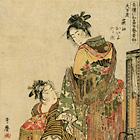Ukiyo-e and Fashion in the Edo Period: Ukiyo-e
-

Geisha's Niwaka Festival in Pleasure District: Ogie, Oiya and Takeji in Omando Ceremony Costume, By Kitagawa Utamaro, Edo period, dated 1783 (Important Art Object)
Japanese Gallery (Honkan) Room 10
July 10, 2012 (Tue) - August 5, 2012 (Sun)Ukiyo-e, or depictions of everyday life in the Edo period (1603-1868), initially developed in the early Edo period as paintings by artists. After this, woodblock printing developed to enable the mass production of ukiyo-e, and innovative carving and printing techniques led to the accomplishment of multicolored nishiki-e prints. This exhibition features the development of ukiyo-e, from early-stage tan-e (prints colored with orange-red), benizuri-e (primitive polychrome prints) and urushi-e (hand-colored prints with an appearance of black lacquer), to the different sized formats of the earliest nishiki-e multicolored prints. Formats of nishiki-e include hosoban (narrow), chuban (medium), and oban (large) in a five-print set. This exhibition also features exceptional seasonal prints, including Kitagawa Utamaro’s three types of work on the theme of the Niwaka performances in the Yoshiwara Pleasure District.
Exhibit includes:
Inside and Outside the Mosquito Net, By Kitagawa Utamaro, Edo period, 18th century (Important Art Object)
Female Performers at the Niwaka Festival in the Pleasure District: Ogiebushi Shingers Oiyo and Takeji in Omando Ceremony Costume, By Kitagawa Utamaro, Edo period, dated 1783 (Important Art Object)
Cooling off in Boats under Ohashi, By Chobunsai Eishi, Edo period, 18th century
